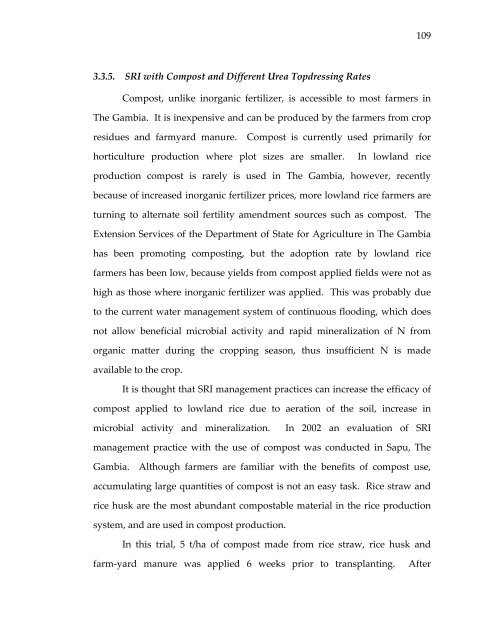Management of rice production systems to increase productivity
Management of rice production systems to increase productivity
Management of rice production systems to increase productivity
You also want an ePaper? Increase the reach of your titles
YUMPU automatically turns print PDFs into web optimized ePapers that Google loves.
3.3.5. SRI with Compost and Different Urea Topdressing Rates<br />
109<br />
Compost, unlike inorganic fertilizer, is accessible <strong>to</strong> most farmers in<br />
The Gambia. It is inexpensive and can be produced by the farmers from crop<br />
residues and farmyard manure. Compost is currently used primarily for<br />
horticulture <strong>production</strong> where plot sizes are smaller. In lowland <strong>rice</strong><br />
<strong>production</strong> compost is rarely is used in The Gambia, however, recently<br />
because <strong>of</strong> <strong>increase</strong>d inorganic fertilizer p<strong>rice</strong>s, more lowland <strong>rice</strong> farmers are<br />
turning <strong>to</strong> alternate soil fertility amendment sources such as compost. The<br />
Extension Services <strong>of</strong> the Department <strong>of</strong> State for Agriculture in The Gambia<br />
has been promoting composting, but the adoption rate by lowland <strong>rice</strong><br />
farmers has been low, because yields from compost applied fields were not as<br />
high as those where inorganic fertilizer was applied. This was probably due<br />
<strong>to</strong> the current water management system <strong>of</strong> continuous flooding, which does<br />
not allow beneficial microbial activity and rapid mineralization <strong>of</strong> N from<br />
organic matter during the cropping season, thus insufficient N is made<br />
available <strong>to</strong> the crop.<br />
It is thought that SRI management practices can <strong>increase</strong> the efficacy <strong>of</strong><br />
compost applied <strong>to</strong> lowland <strong>rice</strong> due <strong>to</strong> aeration <strong>of</strong> the soil, <strong>increase</strong> in<br />
microbial activity and mineralization. In 2002 an evaluation <strong>of</strong> SRI<br />
management practice with the use <strong>of</strong> compost was conducted in Sapu, The<br />
Gambia. Although farmers are familiar with the benefits <strong>of</strong> compost use,<br />
accumulating large quantities <strong>of</strong> compost is not an easy task. Rice straw and<br />
<strong>rice</strong> husk are the most abundant compostable material in the <strong>rice</strong> <strong>production</strong><br />
system, and are used in compost <strong>production</strong>.<br />
In this trial, 5 t/ha <strong>of</strong> compost made from <strong>rice</strong> straw, <strong>rice</strong> husk and<br />
farm‐yard manure was applied 6 weeks prior <strong>to</strong> transplanting. After
















